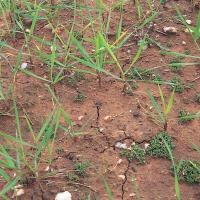Diagnosing pythium root rot in cereals
A widespread fungal root disease that attacks seedlings but which rarely causes large yield losses.
What to look for
- Patches or whole paddocks of very poor growth.
Paddock
- Seedlings pale and stunted.
- Older plants have fewer tillers and may rot and die.
- Affected plants occur in patches where soil is wetter.
- Roots stunted, short and stubby with few laterals.
- Root tips often water soaked and develop a soft yellow to light brown rot.
Plant
What else could it be
| Condition | Similarities | Differences |
|---|---|---|
| Diagnosing rhizoctonia root rot in cereals | Patches of stunted plants and dead roots | Rhizoctonia root rot has spear tip roots and occurs in distinct patches |
| Diagnosing waterlogging in cereals | Stunted plants with dead or dying roots | Waterlogged roots aren't stubby and have water-soaked tips |
Where does it occur?

Wet conditions
- Cold, wet conditions.
- Wet soils and areas of poor drainage.
- Seeding directly into areas of dense dying weeds.
Management strategies
- Good weed control in paddock and delay seeding until weeds have decomposed.
- Use fungicide seed dressings with a Pythium-selective chemical such as metalaxyl-M .
See also
Where to go for expert help
Page last updated: Thursday, 16 April 2015 - 10:09am




